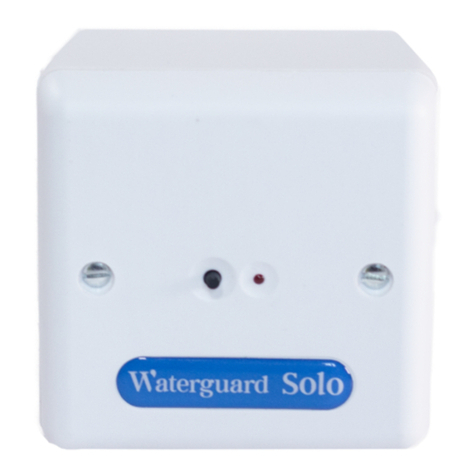
INSTALLATION INSTRUCTIONS / USER MANUAL
5
SAFETY FUNCTION
The wireless valve control uses an internal safety function to prevent extracting the sensor cable by
accident. Should this happen, a repeating 0,5 second signal will be heard, the LED indicator in the reset
switch will flash with a red light and the solenoid valve will close the water. When the contact is put in place
again, the alarm will stop and the valve will open the water again.
If the wired sensor port is not in use, this function is deactivated.
If the sensoe cable by accident is connected, and you later do not wish to use it (you need to disconnect it),
this safety feature can disabled by disconnecting the power, extracting the sensor cable, and reconnect the
power.
NB! Only the contact is monitored, if the sensor cable breaks – that will not trigger the alarm.
AUTO-EXERCISING VALVE
The wireless valve control is equipped with a function that automatically exercises the valve. This will
prevent the pilot valve from being stuck due to particles in the water.
1 second after it is powered, the unit will go through an exercising sequence where the pilot valve will open
and close very fast, without influencing the waterflow.
The unit comes pre-preogrammed with one exercising cycle every 24 hour.
This can be changed to the following frequency:
1 time every 24 hour - 1 time every week - no excersing of the valve.
Reprogramming the exercising cycle
Hold in the Reset-button before the unit is powered, and keep holding it. After 20 seconds an audio signal/
beep will be heard, and this will loop in 3 dierent steps until the Reset-button is released after the seqence
you prefer.
If the Reset button is let go after 1 beep, the valve will exercise every 24. hours.
If the Reset button is let go after 2 beeps the valve will exercise every 7. days.
If the Reset button is let go after 3 beeps the valve will not exercise.
To control the exercise status
Disconnect the power, and after 10 seconds put contact back.
The unit will now emit a number of beeps that corresponds to the chosen exercise frequence.
If you wish to change the exercise cycle, repeat the above explained programming sequence.
NB! When exercising is performed, the voltage wil be cut in the units 230V port. This cut lasts for abt.
300 ms, and might cause connected appliances to change their operating status. Should this happen, it is
not regarded a error on the valve control from Waterguard.
New functionality in this version

































